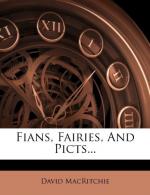The structure last named is described by Captain Thomas and Mr. T.S. Muir in vol. iii. of the Proceedings (pp. 225-228), where it is stated:—“The Amazon’s House is of the same class with our earliest stone buildings—belonging to the era of cromlechs, stone-circles, Picts’ castles, &c.; but while in other parts of Britain the style and type have vanished for a thousand years, in the Outer Hebrides we find them (in the Bothan [i.e., ‘boths’ or ‘bee-hive houses’] of Uig) continued to the present day.” The following additional remarks by Captain Thomas are also of interest in this connection:—“It appears that besides the Tigh na Bhanna ghaisgach (Ty-na-Van-a-ghas-gec), or Amazon’s House—and of whom all tradition, except her name, has gone—there are the remains of other submerged dwellings and hypogea. Miss Euphemia MacCrimmon, the oldest inhabitant of that far-off island, tells that a certain Donald Macdonald and John Macqueen, on passing a hillock, heard churning going on within. And about thirty years ago, when digging into the hillock to make the foundations of a new house, they discovered what seemed to be the fairies’ residence, built of stones inside, and holes in the wall, or croops, as they call them, as in Airidh na Bhannaghaisgach."[74]
It will be noticed that the “beds” in Maes-How are on a higher level than the floor of the main chamber. “In the winter houses,” observes Captain Thomas,[75] “the floor of the bed-place was raised 3 or 4 feet above the ground.”
The original use of Maes-How is a matter of opinion, and some have assumed it to belong to the class of sepulchral mounds, although there is no evidence in support of this belief. For many reasons, the opinions of Captain Thomas are endorsed by the present writer. It may be added that, prior to 1861, when the mound was opened, local tradition had declared that it was the residence of a “hog-boy,” or mound-dweller.
[Footnote 74: Proc. Soc. Antiq. Scot. (First Series), vol. vii. p. 172.]
[Footnote 75: Op. cit., p. 164.]
[Illustration: PLATE XVII.
THE BRUGH OF THE BOYNE, NEW GRANGE, COUNTY MEATH]
[Illustration: PLATE XVIII.
DOORWAY OF THE BRUGH OF THE BOYNE.]
[Illustration: PLATE XIX.
GROUND PLAN OF THE BRUGH OF THE BOYNE (as at present explored).]
PLATES XVII., XVIII., AND XIX.—Brugh
of the Boyne, New
Grange, County Meath.
The diagrams here shown are from drawings by Mr. W.F. Wakeman, the veteran Irish archaeologist.[76] With reference to the spiral carvings at the doorway of the Brugh, it may be mentioned that “the same kind of ornament appears on a stone found amidst a heap which had once been a ‘Pict’s-house’ in the island of Eday, Orkney;"[77] and that in Orkney, also, there has been found, in an underground house, a large stone “saucer,” or “tray,” resembling the two shown in the ground plan of the Brugh. (There appears to be no settled opinion as to the uses of those “saucers.”)




